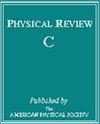Shell structure and shape transition in odd-Z superheavy nuclei with proton numbers Z=117, 119: Insights from applying deformed relativistic Hartree-Bogoliubov theory in continuum
IF 3.4
2区 物理与天体物理
Q1 Physics and Astronomy
引用次数: 0
Abstract
We present a systematic study on the structural properties of odd- superheavy nuclei with proton numbers , and neutron numbers increasing from to the neutron dripline within the framework of axially deformed relativistic Hartree-Bogoliubov theory in continuum. The results are compared with those of even-even superheavy nuclei with proton numbers and 120. We analyze various bulk properties of their ground states, including binding energies, quadrupole deformations, root-mean-square radii, nucleon separation energies, and -decay energies. The coexistence of competing prolate and oblate or spherical shapes leads to abrupt changes in both quadrupole deformations and charge radii as functions of neutron numbers. Compared to even-even nuclei, the odd-mass ones exhibit a more complicated transition picture, in which the quantum numbers of of the lowest-energy configuration may change with deformation. This may result in the change of angular momentum in the ground-state to ground-state decay and thus quench the decay rate in odd-mass nuclei. Moreover, our results demonstrate a pronounced proton shell gap at , instead of , which is consistent with the predictions of most covariant density functional theories. Besides, large neutron shell gaps are found at and in the four isotopic chains, as well as at in the light two isotopic chains with and , attributed to the nearly degenerate and spin-orbit doublet states due to the presence of bubble structure.

质子数为Z=117、119的奇Z超重核的壳结构和形状转变:在连续体中应用变形相对论哈特里-波哥留布夫理论的启示
我们在连续体轴变形相对论哈特里-波哥留波夫理论的框架内,对质子数为 Z=117,119 ,中子数 N 从 N=170 增大到中子滴线的奇数-Z 超重核的结构特性进行了系统研究。结果与质子数 Z=118 和 120 的偶偶数超重核的结果进行了比较。我们分析了它们基态的各种体态特性,包括结合能、四极变形、均方根半径、核子分离能和α衰变能。相互竞争的长形和扁球形或球形的共存导致四极子变形和电荷半径随着中子数的变化而发生突变。与偶数-偶数核相比,奇数质量核的过渡情况更为复杂,其中最低能量构型 Kπ 的量子数可能会随着形变而改变。这可能会导致从基态到基态α衰变过程中角动量的变化,从而淬灭奇数质量原子核的衰变率。此外,我们的结果表明在 Z=120 而不是 Z=114 处存在明显的质子壳间隙,这与大多数协变密度泛函理论的预测一致。此外,在四个同位素链中的 N=172 和 N=258 处,以及在 Z=117 和 Z=118 的两个轻同位素链中的 N=184 处发现了较大的中子壳间隙,这归因于由于气泡结构的存在而产生的近乎退化的 3d 和 4p 自旋轨道双态。
本文章由计算机程序翻译,如有差异,请以英文原文为准。
求助全文
约1分钟内获得全文
求助全文
来源期刊

Physical Review C
物理-物理:核物理
CiteScore
5.70
自引率
35.50%
发文量
0
审稿时长
1-2 weeks
期刊介绍:
Physical Review C (PRC) is a leading journal in theoretical and experimental nuclear physics, publishing more than two-thirds of the research literature in the field.
PRC covers experimental and theoretical results in all aspects of nuclear physics, including:
Nucleon-nucleon interaction, few-body systems
Nuclear structure
Nuclear reactions
Relativistic nuclear collisions
Hadronic physics and QCD
Electroweak interaction, symmetries
Nuclear astrophysics
 求助内容:
求助内容: 应助结果提醒方式:
应助结果提醒方式:


